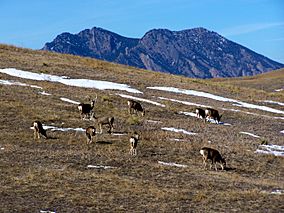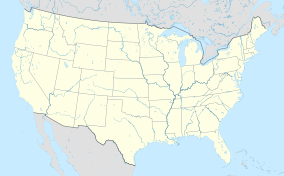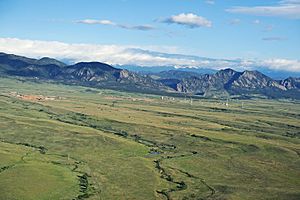Rocky Flats National Wildlife Refuge facts for kids
Quick facts for kids Rocky Flats National Wildlife Refuge |
|
|---|---|
|
IUCN Category IV (Habitat/Species Management Area)
|
|
 |
|
| Location | Jefferson County, Colorado, United States |
| Nearest city | Arvada |
| Area | 5,237 acres (2,119 ha) |
| Established | 2007 |
| Governing body | U.S. Fish and Wildlife Service |
| Website | Rocky Flats National Wildlife Refuge |
The Rocky Flats National Wildlife Refuge is a special natural area in the United States. It covers about 5,237-acre (21.19 km2) of land. This refuge is located about 16 miles (26 km) northwest of Denver, Colorado. It sits west of Broomfield and Westminster, and north of Arvada.
Contents
What the Refuge Aims For
The Rocky Flats National Wildlife Refuge is a large area of grasslands, shrublands, and wet areas called wetlands. It even has a rare type of dry, tall grass prairie. This refuge helps nature thrive and supports many different kinds of native animals. The people who manage the refuge work to protect its special plants and animals. They also help keep wildlife populations healthy where the mountains meet the prairies in Colorado.
Amazing Animals and Plants
This refuge is home to many different animals. You might see a herd of about 150 elk here. Sometimes, black bears, mountain lions, and moose visit too. Other animals living here include badgers, bats, coyotes, and two kinds of owls. You can also spot mule deer, northern flicker birds, white pelicans, black-tailed prairie dogs, and porcupines. The refuge is also a home for an estimated 630 different types of plants!
A Look at the Refuge's History
The Rocky Flats National Wildlife Refuge is one of more than 560 refuges in the National Wildlife Refuge System. This system is a network of lands set aside and managed by the U.S. Fish and Wildlife Service. These lands are specifically for protecting wildlife. The Rocky Flats Refuge is located where Jefferson, Boulder, and Broomfield counties meet in Colorado.
Long ago, Native Americans lived on this land from time to time before the 1800s. Later, in 1868, the Scott family started a homestead here and raised cattle. In the 1940s, the Lindsay family also raised cattle and built a house and barn.
In 1951, the U.S. Atomic Energy Commission bought about 2,519 acres of this land. This included the Lindsay family's property. They used it to build the Rocky Flats Plant. This plant made parts for nuclear weapons. In 1974, another 4,027 acres were bought to make the plant bigger.
This 6,500-acre site was one of 13 places in the United States that made nuclear weapons during the Cold War. The plant operated from 1952 to 1994. The manufacturing work happened in the middle of the site, with a large safety zone around it.
In 1992, the plant's main job ended. All nuclear and non-nuclear production stopped in 1993. The last materials related to defense were sent away in 1994.
The site then needed a huge environmental cleanup. It was added to the U.S. Environmental Protection Agency’s (EPA) Superfund List in 1989. The cleanup cost $7 billion and was finished in 2005. The U.S. Department of Energy (DOE) still manages 1,300 acres of the original site. This is for long-term care and to make sure the cleanup continues to work. These 1,300 acres are not part of the public refuge.
The Rocky Flats National Wildlife Refuge is made up of the lands that used to be the safety zone around the plant. After the cleanup, experts found that these lands were safe for people to use without limits. In 2001, a law called the Rocky Flats National Wildlife Refuge Act turned most of the 6,240-acre (25.3 km2) site into a refuge. This happened after the EPA confirmed that the cleanup was complete. The refuge does not include the 600 acres where the old weapons site was. That area remains closed to the public.
While many people were excited about the new park, some had questions about its safety. However, the U.S. Fish and Wildlife Service opened the refuge’s trails on September 15, 2018.
Why the Refuge is Important
The Rocky Flats National Wildlife Refuge has several important goals:
- It works to bring back and protect the natural ecosystems of the area.
- It provides a safe home for native plants and animals, including those that migrate.
- It helps protect species that are threatened or endangered.
- It offers chances for scientists to do important research in a way that doesn't harm nature.
What the Refuge Hopes to Achieve
The refuge has clear goals to help it succeed:
- Wildlife and Habitat Management: To create a healthy river-side environment that looks like the historical area. This helps provide homes for birds, mammals, and animals that depend on rivers.
- Public Use and Learning: To give visitors and students great chances to enjoy nature, learn, and understand the refuge's unique habitats. This includes the dry tallgrass prairie, shrublands, wetlands, native wildlife, and the site's history.
- Safety First: To make sure that all activities and public access follow the cleanup plans. This keeps visitors, staff, and neighbors safe.
- Clear Communication: To share information with the public about the refuge's programs and what it does.
- Working Together: To build good partnerships with people, government groups, and non-profit organizations. This helps protect natural resources.
- Refuge Operations: To have the right facilities and staff to achieve the refuge's vision and purpose, using the money available.
Current Status of the Refuge
The main plan for the refuge focuses on protecting wildlife and their homes. It also allows for a moderate amount of public use that depends on wildlife, like hiking and observing nature.
In 2015, a court decision allowed a land exchange that added over 600 acres to the refuge. It also gave the refuge control of over 1,200 acres of underground mineral rights. In exchange, a 300-foot transportation path was created along the refuge's eastern edge.
The wildlife refuge opened for two guided hikes in September 2015. It officially opened to the public on September 15, 2018.



